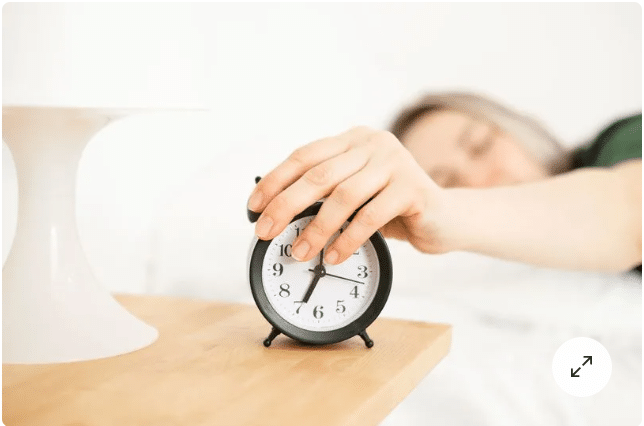If you’ve ever been stuck in a cycle of staying up too late and waking up groggy, you’re not alone. I was right there with you not getting enough sleep, feeling constantly drained, and snoozing my alarm like it was my job. According to the National Institutes of Health (NIH), adults need 7–9 hours of sleep each night, but I was clocking in at six on a good day.
Going to bed earlier felt like a punishment, and my habit of doom-scrolling didn’t help. But I’ve finally cracked the code with a super simple trick and it’s completely changed my sleep schedule. Trust me, if I can do it, you can too.
How I Fixed My Sleep Schedule

Instead of forcing myself to go to bed an hour earlier overnight (which I failed at every time), I followed advice from sleep experts to adjust my bedtime gradually. Here’s how it worked:
- Start Small:
- I began by going to bed just 15 minutes earlier each week.
- Week 1: 11:15 p.m. instead of midnight.
- By Week 4: I was in bed by 10:30 p.m., and it didn’t feel like a big change.
- Be Consistent:
- I kept the same wake-up time every day even on weekends. This helped reset my body’s internal clock (aka my circadian rhythm).
- Focus on the End Goal:
- My motivation? Waking up without hitting snooze 10 times. After a month, I was getting up at 6:30 a.m. without feeling like a zombie.
The Science Behind This Hack
Dr. Raj Dasgupta, a sleep expert, explains why this works:
“Your body’s internal clock needs time to adjust. Moving your bedtime by 15-minute increments allows your circadian rhythms to align with the new schedule.”
Trying to shift an hour at once? That’s like asking your brain to sprint after sitting all day, it’s too much, too fast.
Other Hacks That Helped Me
Adjusting my bedtime wasn’t the only thing that saved my sleep schedule. These five game-changing strategies made a huge difference too:
1. Cognitive Shuffling: The 5-Minute Sleep Trick
This hack is perfect if your mind won’t stop racing at night. Here’s how it works:
- Pick a random word (e.g., “sleep”).
- For each letter, think of as many unrelated words as possible:
- S = Sun, Sandwich, Snowman
- L = Lemon, Ladder, Lake
- E = Elephant, Engine, Envelope
- Visualize each word as you go.
This technique keeps your brain occupied with random thoughts, breaking the cycle of overthinking. It’s like hitting “shuffle” on your mental playlist no more spiraling about tomorrow’s to-do list.
2. Create a Relaxing Evening Routine
I swapped my usual TV binge for calming activities:
- Dim the lights: Soft lighting tells your brain it’s time to wind down.
- Read a book: A real one, not on my phone.
- Sip herbal tea: Chamomile is my go-to.
3. Stop Using Screens Before Bed
Blue light from phones and laptops messes with melatonin (the sleep hormone). I started turning off my devices an hour before bed or at least switched to “night mode” when I couldn’t resist.
4. Keep a Consistent Sleep Schedule
Even on weekends, I stuck to my 10:30 p.m. bedtime and 6:30 a.m. wake-up. After a few weeks, my body naturally adjusted to the new routine.
5. Make My Bedroom a Sleep Sanctuary
I made small changes to my space that had a big impact:
- Kept the room cool (around 65°F).
- Used blackout curtains to block light.
- Added a lavender diffuser for a relaxing scent.
Tips for Better Sleep (Backed by Science)
If you’re looking to improve your sleep, here’s a quick cheat sheet:
| Problem | Solution |
|---|---|
| Trouble falling asleep | Try cognitive shuffling, meditation, or deep breathing exercises. |
| Waking up during the night | Use a white noise machine or earplugs to block disturbances. |
| Feeling groggy in the morning | Get sunlight exposure within an hour of waking up to reset your circadian rhythm. |
| Can’t stop scrolling at night | Use blue light-blocking glasses or turn on your device’s “night mode” feature. |
| Overthinking before bed | Write down your thoughts in a journal to clear your mind. |
FAQs: Your Sleep Questions Answered
1. How much sleep do I actually need?
Most adults need 7–9 hours of sleep per night. If you’re waking up tired, try going to bed 15 minutes earlier until you find your sweet spot.
2. Does cognitive shuffling really work?
Yes! This technique distracts your brain with random, unrelated thoughts, helping you transition into sleep. It’s simple, but surprisingly effective.
3. What if I wake up in the middle of the night?
Get out of bed and do something calming (like reading) in low light. Lying there stressing about it will only make it harder to fall back asleep.
4. Can I sleep in on weekends?
It’s tempting, but try to wake up within 30 minutes of your usual time. Sleeping in can throw off your internal clock, making Monday mornings even harder.
5. How long does it take to fix my sleep schedule?
It depends on how big the change is, but most people see improvements within a week or two. Gradual adjustments are key.
Why Sleep is Worth It
Fixing my sleep schedule wasn’t easy at first, but it was 100% worth it. I feel more energized, focused, and honestly, just happier. The little changes like moving my bedtime by 15 minutes each week added up to big results.
If you’re struggling with sleep, try these hacks and see what works for you. Everyone’s different, so it might take some experimenting. And if nothing seems to help, don’t hesitate to talk to a doctor or sleep specialist, they can help you uncover deeper issues.
Sleep isn’t just about avoiding grogginess, it’s about showing up as your best self every day. Sweet dreams!
References
- National Institutes of Health. (2024). Sleep and Health: Why It Matters. Retrieved from https://www.nih.gov
- Dasgupta, R. (2024). How to Fix Your Circadian Rhythm for Better Sleep. Sleep Medicine Insights.
- NHS. (2024). Cognitive Shuffling and Sleep Improvement. Retrieved from https://www.nhs.uk
- Sleep Foundation. (2023). Sleep Hygiene Tips. Retrieved from https://www.sleepfoundation.org
- Chesters, J., & Rajan, K. (2024). Cognitive Shuffling: A Game-Changing Sleep Hack. TikTok Series.


